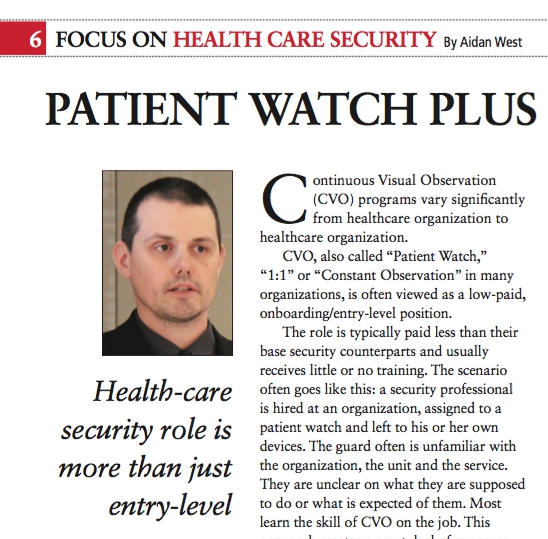
Focus on Health Care Security: Patient Watch Plus
By Aidan West
Features Expert Advice Opinion aidan west authority to detain constant observation continuous visual observation cooper colour codes cvo north bay patient watch risk mitigation strategies search parameters situational awareness threat risk assessment traContinuous Visual Observation (CVO) programs vary significantly from healthcare organization to healthcare organization.
CVO, also called “Patient Watch,” “1:1” or “Constant Observation” in many organizations, is often viewed as a low-paid, onboarding/entry-level position.

The role is typically paid less than their base security counterparts and usually receives little or no training. The scenario often goes like this: a security professional is hired at an organization, assigned to a patient watch and left to his or her own devices. The guard often is unfamiliar with the organization, the unit and the service. They are unclear on what they are supposed to do or what is expected of them. Most learn the skill of CVO on the job. This approach creates a great deal of exposure for the organization and can lead to critical incidents and adverse patient outcomes such as elopement, self-harm and suicide. This will negatively reflect on the security service and its brand.
As we have seen recently with the steady number of reports of hospital worker exposure to violence, the reliance on security will continue to increase. In order to effectively mitigate these risks and ensure the safety of all staff and patients, the approach to CVO needs to change.
In preparing security professionals for CVO, the following are key elements that should be present in a successful program:
Leadership endorsement
Directors, managers and supervisors need to demonstrate the value and importance of the role. This can be done in a number of ways, such as: developing a robust training program; ensure only trained staff conduct CVO; posting standard operating procedures that outline expectations and aspects of an effective CVO; and ensure supervisor contact throughout the course of the CVO.
Training
Before being permitted to work CVO shifts, a security professional should receive targeted training that focuses on aspects such as: Situational Awareness (Cooper colour codes); Threat Risk Assessment (TRA) tools; risk mitigation strategies; authority to detain (legislative acts that apply); search parameters and roles; responsibilities and expectations; annual re-training in CVO skills should be required.
Compensation
Ensure security guard salaries are reflective of the high risk nature of the position and are in line with base security compensation.
Metrics and measures
As part of the service operation plan there should be an objective tied to CVO and reflected on the departmental scorecard. This should be available to all staff, and routinely reviewed and successful milestones should be celebrated.
Culture
Change the organizational approach and thinking around CVO. This change should recognize that:
• The role is a key risk mitigation function that can prevent significant patient events and avert possible litigation
• It is not an entry level position but a skilled role requiring a trained seasoned professional.
• It is a key component of a service’s recruit and retention strategy as it creates work opportunities for part-time and casual employees
The success of any CVO program will depend on the level of investment the organization makes into the program. By providing staff with the knowledge, skills and tools to utilize during a “patient watch,” acknowledging the role as a skilled position, ensuring compensation equity with other departmental roles and clearly outlining expectations will empower staff, raise the standard of professionalism and the overall reputation of the hospital security service.
Aidan West is a Registered Nurse & Licensed Security Professional and the Manager of Integrated Risk Service at the North Bay Regional Health Centre. West delivered a presentation on continuous visual observation Focus on Health Care Security, held in Toronto on Dec. 7, 2016.
Print this page
Advertisement
- Manitoba border community sees burst of refugees arriving on weekend
- Arteco, Oncam and SANS Technology found Campus Security Coalition
Leave a Reply